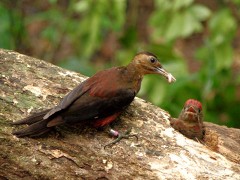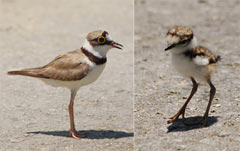Young Okinawan woodpeckers safely leave their nest in a tree blown down in a typhoon

Okinawan woodpecker raises its chicks in a nest in an itaji tree that fell over. The parent bird feeds the young one in Nishime-dake, Kunigami Village on June 28 (photograph provided by Yutaka Toguchi).
July 6, 2011, Ryukyu Shimpo
Two Okinawa woodpecker chicks safely left their nest in an itaji tree (biological name: Castanopsis sieboldii) blown over by the strong winds of Typhoons No.2 and No.5 in Nishime-dake, Kunigami Village.
This situation was confirmed by 48 year-old Yutaka Toguchi, who has been commissioned by the Ministry of the Environment (MOE) to conduct a survey on Okinawan woodpeckers.
A representative of the Yambaru Wildlife Conservation Center of the MOE said that, “The chicks successfully left a nest in a fallen tree, something that we have never seen before.”

Little ringed plover (on left) and the chick in Yagaji Island, Nago City on July 3 (photograph provided by Yutaka Toguchi).
On July 3, Toguchi also observed two young little ringed plovers (biological name: Charadrius dubius) and another two parent birds on Yagaji Island, which is designated as a wildlife reserve. Yagaji Island is the fourth location in Okinawa where little ringed plovers are known to breed, and this is the first time to confirm this occurring in the northern part of the prefecture.
Toguchi happily said, “I have been observing birds for thirty years, but I now feel like my dream has come true.”
Toguchi found an egg of an Okinawan woodpecker in a nest build in a dead itaji tree.
The strong winds of Typhoon No.2 broke its trunk and the tree started leaning on the one next to it.
The parent bird continued to protect the eggs and two chicks were confirmed as being alive.
The winds of typhoon No.5 completely blew the tree over, but the parent bird continued feeding its young, which then left the nest on June 29 and July 2.
When a tree in which a nest is built falls to a ground, it is highly likely that any chicks inside could be preyed upon by their natural enemies or could drown in rainwater that might pour into the nest.
Toguchi said happily, “It’s a miracle for chicks to safely be able to leave the nest in this kind of situation. Those typhoons caused severe damage throughout the whole prefecture, but the Okinawan woodpeckers are still going strong.”
Little ringed plovers usually breed in locations north of Kyushu and then migrate to Okinawa for the winter. It is very rare for them to breed in Okinawa.
While little ringed plovers normally breed on dry riverbeds, these birds were confirmed to be breeding near sediment dredged up in a fishing port in Yagaji Island. It seems that two or three days had passed since the chicks hatched.
Toguchi said, “The chicks are finding their feet now, but they will become able to fly within about 20 days. I will continue to keep an eye on them.”
(English Translation by T&CT, Mark Ealey)
Previous Article:JASDF F-15 crashes into sea 140 km off the coast of Ie-jima
Next Article:Worldwide Eisa Festival to be held on October 15
[Similar Articles]
- Protecting Japanese white-eye chicks with a parasol “Feeling like a bird parent” Chatan’s Mr. Yonaha, looking forward to baby birds fledging
- Little tern, please grow up healthy and strong!
- Okinawa Woodpecker busily rearing its chicks
- Okinawa woodpecker habitats move south to Nago area
- Little terns: Nurturing love in material storage area
 Webcam(Kokusai Street)
Webcam(Kokusai Street)


